Keeping tea bags in a beautiful house is more aesthetically pleasing than just in a box. Such an item will be a great decor and will fit into the interior. Decoupage technique allows you to create amazing objects so easily that the whole family can do it. Do-it-yourself home can be presented to relatives or friends. Such a thing looks cute and gives the kitchen more comfort.

Necessary materials and tools
It may seem to beginners that starting decoupage is quite difficult. Long and incomprehensible lists of materials and tools are literally driven into a stupor. It’s worth sorting everything in order to understand what is really needed for the job.
The basis for decoupage is necessary in any case. There are three-dimensional figures, but their decoration is quite troublesome and this is not the best idea for the first work. For a tea house, you can use flat pieces of plywood, wood or cardboard.
A simpler option would be to purchase a finished assembled layout of the same materials.

With certain skills, the foundation can be done independently.
Tools are of great importance in the work. Both the quality of work and your pleasure in the process of its implementation directly depend on them. So, this is what you need to stock up on.
Synthetic Brush
It will take a few flat ones, approximately No. 10 and 20. For decoration, you can use a thin round brush. Small brushes will help out if you need to outline something, tint. Wide will provide convenient varnish application.

Putty knife
The rubber tool is sold at a hardware store and is intended for applying embossed paste or for leveling the surface.
If you wish, you can buy a palette knife or even use the old plastic card.

Sandpaper
You need to have several sheets of different abrasiveness.
It is better to choose products with a fabric base, then a light house will not get dirty during the grouting process.
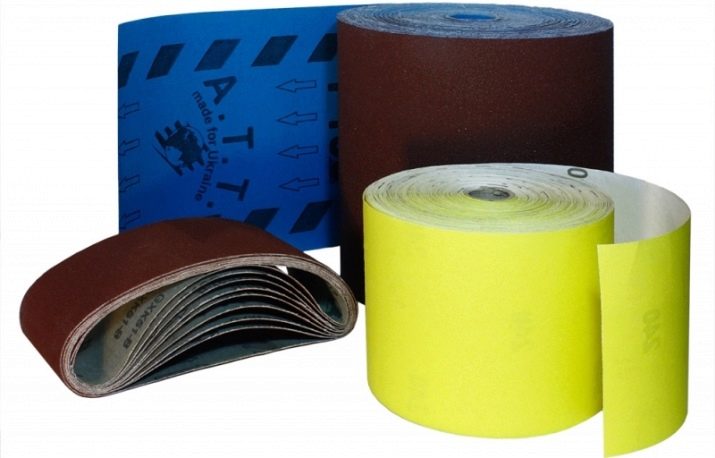
Foam rubber sponges
You can buy or build from improvised materials. Sponges for applying cosmetics or finely porous sponges are well suited.

Palette
You can buy a tool or build an alternative yourself. It is permissible to use disposable tableware with its subsequent discarding. Another option is to take a plate of glass, because acrylic paints are easily washed off.

Additional tools
These include a glass for washing brushes and napkins for drying them. A file folder for sticking a motive, scissors and all that sort of thing. Such a tool is not always used, but it is still necessary.

Materials are equally important for high-quality and simple work. There are many tools marked "for decoupage", but do not buy everything. The necessary materials are listed below.
Motive
The most important thing for the future product. Many work with napkins because they are affordable.
For starters, it's still easier to use decoupage cards made of paper or rice paper. They are more expensive, but they are easier to stick.
The application process will be enjoyable, and as a result there will definitely not be holes or creases.


Acrylic primer
It provides the longevity of the house. Materials will adhere better to the surface of the substrate. White soil will not only hide defects on the workpiece, but also lighten it. Subsequently, this treatment will significantly reduce paint consumption. If desired, take a small jar, but do not refuse it.

Acrylic paints
Define the main colors of work and buy small containers with material. Remember that paints can be mixed to create a new color.

Acrylic lacquer
It is recommended to use a water-based product: it dries quickly, does not have a specific smell and is easily washed off the brushes.
It is optimal to take a semi-gloss varnish - it is considered universal.
In general, you can choose any degree of gloss to your liking.
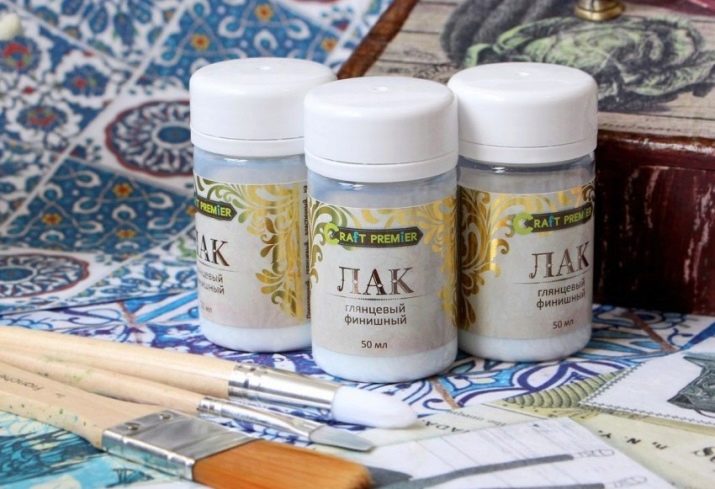
Decoupage adhesive
It is used for gluing motifs to the workpiece. It is better to use a special tool or glue-varnish, which combines two functions at once.
If you can’t find the right material, then glue the motif directly on acrylic varnish. Use PVA is not worth it, it eventually turns yellow and exfoliates.

Acrylic outline
The material is not considered mandatory, but greatly simplifies the decoration.
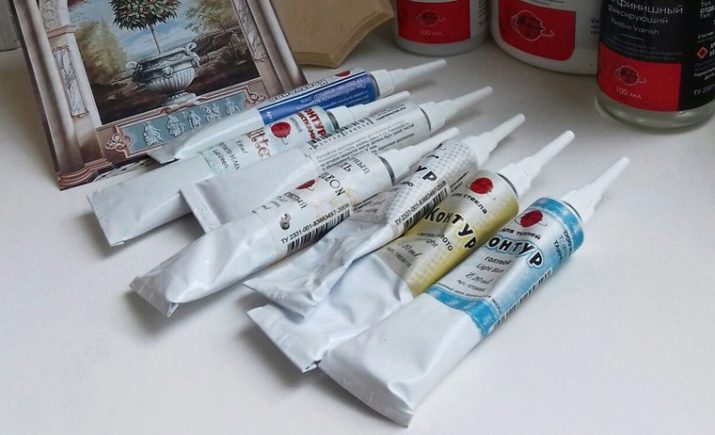
Style selection
Decoupage allows you to perform fascinating work. Designing in a certain style will help to make such a house that fits best into the interior. The most popular decoupage options.
Provence
The surfaces are whitened before decoration, and pastel colors are used during the work. Provence personifies discreet antiquity, therefore, products in this style are distinguished by scuffs and roughnesses. Usually motifs with lavender, sunflowers, grapes are used. Images of small houses like huts are popular.
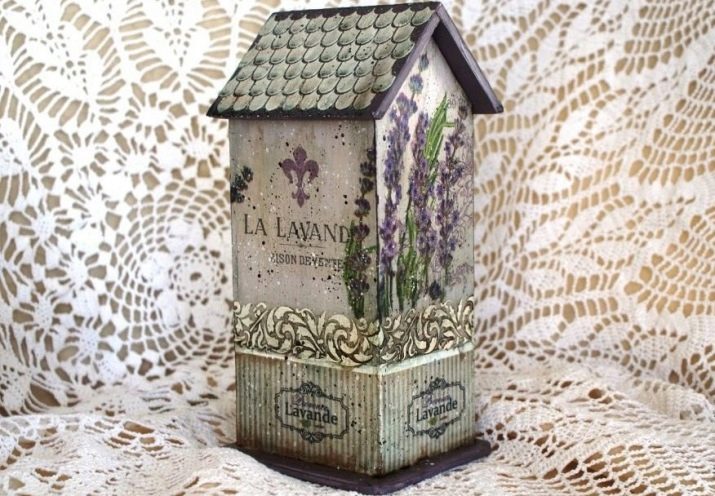
Shabby chic
The first word from English is translated as shabby or well-worn. Gentle tones and slight blurriness of images are typical for this style. Motifs contain floral ornaments, castles, birds and angels.

Simplicity
Democratic style, which is permeated with fresh trends. Clippings from fashion magazines and newspapers are used as motives most often. Images are different deliberately torn edges.
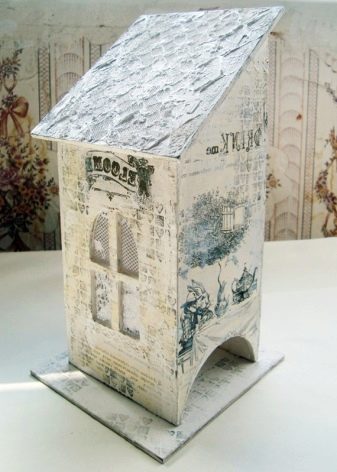

Victorian style
Classics and luxury are woven together and the result is simply amazing. When decorating, saturated and rich colors are used. Masters combine gold, red and green shades.As motifs, ornaments with stripes and cells are used. Victorian style implies the use of drawings with roses, animals, oak leaves; scenes with hunters and game are welcome.

A product using decoupage technique can be designed for a particular holiday or event. New Year's tea houses are very popular, especially as a gift to loved ones. Work can be devoted to important dates, such as a wedding or the birth of a child.

Workshops for beginners
The tea house is suitable for bags and helps not only to create a cozy atmosphere, but also to maintain order in such an important place at home. You can decorate a product using decoupage technique in any style that you like and suits your interior. It is convenient to perform work from wooden blanks, you can see different options. Products in the form of a mill, a telephone box are popular; houses with a balcony look cute.

Regardless of what kind of basis the work has, the work itself is the same. To do the work yourself, you will need such materials:
- glue or varnish-glue for decoupage, which is intended for the treatment of hard surfaces;
- embossed acrylic paste "burnt brick";
- blank from plywood or wood;
- acrylic, matte varnish;
- acrylic primer;
- paints of red, green, white and olive colors;
- suitable motif for decoupage.
The tea house will be decorated using decoupage technique with a combination of acrylic splashes, which looks very impressive and bewitching.
Embossed paste will help make the roof more realistic.

Step-by-step execution of work is given below.
- Cover the entire workpiece with soil. You can use not only a brush, but also a small construction roller.
- Paint the workpiece with olive paint and wait for it to dry.
- Cut out from the napkin that part of the picture that you want to put on the house.
- Remove the white backing from the cloth so that only the decorative layer remains.
- Take the stationery file and lay the napkin on top with the pattern down. Gently moisten with clean water. It is convenient to use a sponge or sponge for soaking.
- Cover the napkin with another file on top.
- Smooth the drawing so that all the air comes out.
- Carefully remove the top file.
- Transfer the drawing with the file to the blank. Just gently attach it so that the image snaps into place.
- Smooth the image through a file. Gently pry and remove it so as not to tear the tissue.
- Brush glue varnish over a napkin. Leave to dry.
- Cover the roof of the house with relief paste. Use a spatula or other suitable tool to shape the tiles. The process will be easier if you buy in advance or make a special stencil. In this case, you need to apply the paste on top, and then gently pull out the substrate until the material dries.
- Paint the inside of the roof and its edges red.
- If the napkin is past the edges of the workpiece, then gently sand it with soft sandpaper.
- Green paint on the inside of the house and the backing.
- Carefully circle the windows with white.
- Dampen the sponge in green paint and process the edges of the house so as to hide the edges of the napkin.
- Using the same principle, treat the stand with a sponge dipped in olive paint.
- Dip a small, dry brush in white paint. Process the facade.
- Spray the walls with red paint using an old hard toothbrush.
- Coat the house with varnish 2-3 times. Each coat must dry completely before applying the next.

Good examples
Novice masters often simply can not collect their thoughts before completing the first work. Many interesting motifs on the shelves of the store cause a desire to buy everything, eyes literally run up. Creative ideas help you find inspiration.
- A simple shape is decorated with interesting cutting. The cup on the wall attracts attention and creates a special emphasis.

- The house is designed for two varieties of tea. To facilitate the work, you can purchase or make a stencil for lace.

- A mill with flowers looks pretty interesting. A small detail in the form of a bow adds to the product of soulfulness.

- Classic shabby chic mesmerizes with simplicity and grace. Such a house will fit perfectly into a bright interior.
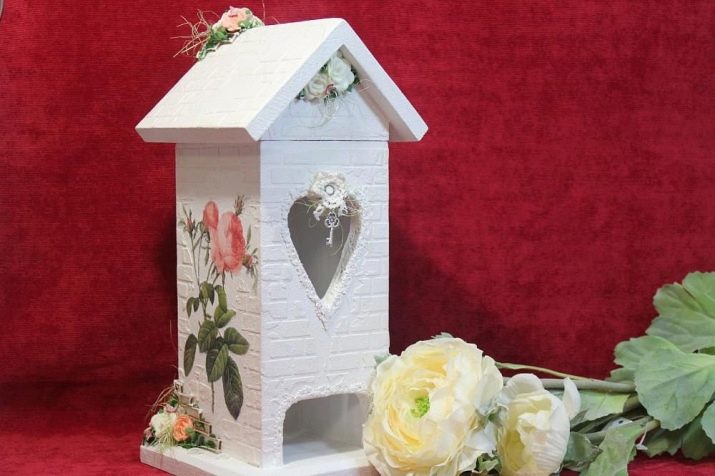
- A vivid example of how a successful combination of drawings works wonders. The tea house resembles a hut.

- Tea house with a chocolate roof. One look at such a product causes a feeling of warmth and comfort.

How to make a decoupage of a tea house, you can see in the next video.










